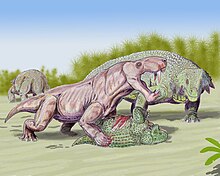
Back Perm (geologie) Afrikaans Perm (Geologie) ALS العصر البرمي Arabic Permianu AST Perm dövrü Azerbaijani Пермскі перыяд Byelorussian Пермскі пэрыяд BE-X-OLD Перм (период) Bulgarian Permian Breton Perm (period) BS

Permium[1][2] est systema stratigraphicum et periodus geologica.
Divisio suprema constituit aerae Palaeozoicae, sexta autem ab infima aeonis Phanerozoicae. Abhinc 2989 ± 1.5 centies milium annorum coepit, antecessore Carbonifero. Finem habuit abhinc 2521.7 ± 0.6 centies milium annorum, successore Triassico, secundum scalam aevorum geologicorum Commissionis Internationalis Stratigraphicae.[3] Permium inceptum ab antiquissimis fossilibus Streptognathodus isolatus datur.[4] Terminus Permius Triassicus eodem tempore quo maxima specierum exstinctio incidit.


In tris series dividitur, quae ab infima ad supremam Cisuralium, Guadalupium, Lopingium appellantur. In novem stadia dividitur, quae ab infimo ad supremum Asselium, Sakmarium, Artinskium, Kungurium, Roadium, Wordium, Capitanium, Wuchiapingium, Changhsingium appellantur.[5]
Nomen anno 1841 e gubernio Permiensi imperii Russici (territorio Permiensi hodierno) deduxit Rodericus Murchison sub forma Anglica Permian system. In illo gubernio cum Eduardo de Verneuil strata amplissima huius systematis nuper exploravit.[6][7]
- ↑ "Oberes Permium (259,8–252,2 Mill Jahre)" contextu Theodisco hic habes.
- ↑ "Perm": Christof Kuhn, "Etymology of Geological Time Units". Rarissime "Permicum."
- ↑ "International Chronostratigraphic Chart."
- ↑ Ita de:wiki.
- ↑ "Internationale Chronostratigraphische Tabelle" (2017).
- ↑ "Permian System (Zechstein of Germany—Magnesian limestone of England): Some introductory remarks explain why the authors have ventured to use a new name in reference to a group of rocks which, as a whole, they consider to be on the parallel of the Zechstein of Germany and magnesian limestone of England. They do so, not merely because a portion of deposits has long been known by the name "grits of Perm," but because, being enormously developed in the governments of Perm and Orenburg, they there assume a great variety of lithological features": R. I. Murchison, E. de Verneuil, A. von Keyserling, On the Geological Structure of the Central and Southern Regions of Russia in Europe and of the Ural Mountains (Londinii: Richard and John E. Taylor, 1842) p. 14
- ↑ De historia nominis definitionisque vide: Mary Grace Wilmarth, The Geologic Time Classification of the United States Geological Survey Compared With Other Classifications, accompanied by the original definitions of era, period and epoch terms (United States Geological Survey Bulletin no. 769. Vasingtoniae: U.S. Government Printing Office, 1925) (p. 70 apud Google Books).